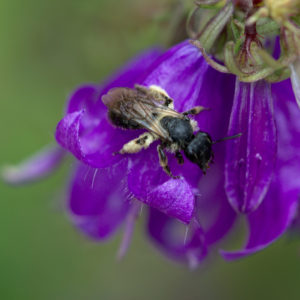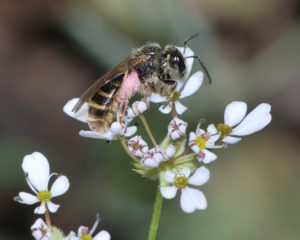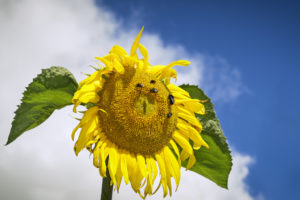Though grapevines are not insect pollinated, taking care of the worlds’ pollinators, particularly bees (both farmed and wild bees) of critical importance to agriculture and our food supply (in addition to countless other ecological and environmental reasons). In fact, figures from the Food and Agriculture Organization of the United Nations state that “three out of four crops across the globe producing fruit or seeds for human use as food depend, at least in part, by pollinators”. While bees aren’t the only organism that can pollinate plants, they do the vast majority of the work by far. That being said, it is everyone’s responsibility to take measures to ensure healthy bee populations, even if those bees do not directly impact their specific crop or plant (like wine grapes).

Photo courtesy Flickr user Magnus Hagdorn
Most of the time, when you think of bees as pollinators, you think of honey bees. True, they play a big role in pollinating the worlds’ plants, but wild bees are actually responsible for just as much, if not more, of the pollinating than farmed honeybees. In fact, studies have shown that wild bees are actually more efficient at pollinating crops and other plants than honeybees.
In order to help foster healthy wild bee populations, land owners, agriculturalists, and viticulturalists should do their part to provide the necessary food and shelter sources for these species. Speaking to viticulture, while bees aren’t necessary for pollinating wild grapes (they are mainly self-pollinating, with wind and insect pollination playing only a minor role), vineyards take up a huge chunk of space that could potential disrupt nesting sites and food sources for wild bees that would pollinate other nearby plants or crops. To help maintain our wild bee populations, viticulturalists may consider different ways to improve nesting site or food resource availability, while at the same time leaving either a positive or at least neutral impact on the productivity of the vineyard itself.
A new study, published in the journal Agriculture, Ecosystems & Environment, aimed to evaluate the effects of different field and landscape conditions on wild bee species’ richness, abundance, and diversity in wine grape vineyards, to determine what conditions or treatments might result in the healthiest wild bee populations, which could have implications for agriculture and the environment as a whole.
Brief Methods
Study vineyards were located in two viticultural areas in Austria: Carnuntum and Neusiedlersee-Hügelland. Vineyards within the study area were mostly small or medium-sized parcels of 0.4-1.0 hectares, with trellis systems and both flat and hilly terrain.
A total of 16 vineyards were studied over two years (2015-2016), aged between 6 to 58 years and comprised of both red and white grapes (Zweigelt, Blue Frankish, Blue Portuguese, Grüner Veltliner, Welschriesling, White Burgundy, Chardonnay, and Muscatel).
The study vineyards were subject to two different tillage procedures: half of the vineyards had no tillage (permanent vegetation cover for at least the last 5 years), while other half had alternating tillage (tilling every second interrow one to three times annually for temporary vegetative coverage).
Wild bees were sampled on five occasions between April and August (at the sign of first leaf buds, first flower buds, full bloom, when grapes were the size of peas, and finally at the beginning of maturation.
Bees were collected and identified in the lab. The following were also measured and analyzed during the give sampling events: floral resources available, nests observed, flower coverage, number of flowering plants. Activity ranges for each bee species sampled were calculated.
Field mapping was performed to evaluate landscape parameters. Shannon Diversity Index (calculates species diversity in an area) as well as average landscape slopes were also calculated.
Honey bees were not included in the analysis, as since they mostly reside in farmed hives, they are not considered to be “wild” for the purposes of this study.
Selected Results
- Over the two-year sampling period, 84 wild bee species and 493 individual bees were identified across the 16 Austrian vineyards.
-

Photo By Gideon Pisanty (Gidip) – Own work, CC BY 3.0, https://commons.wikimedia.org/w/index.php?curid=18334263
The most abundant species (19%) was Lasioglossum marginatum.
- Lasioglossum laterale was found for the first time in Austria.
- The were no differences in wild bee species richness or abundance between the two viticultural areas of study.
- Forage availability (e.g. appropriate food resources) had the largest positive effect on wild bee species richness and abundance.
- Untilled interrows had a slight negative effect on wild bee species richness and diversity, compared with the alternating tillage regime.
- The alternating tillage vineyards had higher forage availability and flower species richness compared with untilled interrows.
- On a larger scale, closeness to villages or other semi-natural elements (not intensively managed natural habitats) positively impacted wild bee species richness and abundance.
- Percentage of artificial areas (e.g. villages) was more positive for wild bee species richness than closeness to semi-natural elements.
- Closeness to semi-natural elements was more positive for wild bee species abundance than the percentage of artificial areas.
- Percentage of woods nearby had a positive effect on wild bee species richness and abundance, though this effect was relatively small.
- 72% of the bees identified were ground-nesting.
- 88% of the bees identified were polylectic (e.g. they forage on many different unrelated plants).
- Oligolectic bees were only found in vineyards that had very high forage availability (i.e. these bees only visit specific plants, so having high forage availability means more plants to choose from and thus greater chance the bees “plant of choice” was present).
- 57% of wild bees sampled were eusocial (only one female reproduces while the rest do other jobs), 40% were solitary (all females reproduce and have their own individual nests), and 3% were parasitic.
- Eusocial species were found more often in untilled interrows and in areas with higher proportion of woods nearby.
- Solitary species were found more often in alternating tillage vineyards as well as in areas with more single stand-alone trees.
- Solitary species were found more often when there were more insect-pollinated crops nearby.
Conclusions
The results of this study provide a glimpse into how different tillage practices can influence wild bee species richness and diversity in a wine grape vineyard. From these results, it would appear as though alternating tillage rows is better for wild bee species richness and abundance than no tillage (permanent cover crop), though results are dependent upon which bee species you’re focusing on and what other landscape or human features may be nearby. Considering all species as a whole, alternating tillage seems to be best, as it provides a greater diversity of plants and thus greater foraging availability for many different wild bee species.
Woods and nearby villages appeared to improve wild bee species diversity, likely due to increase nesting site availability for the insects as well as additional food resources.
Interestingly, ground tilling did not impact nesting sites for ground-nesting species, which the authors of the study attributed to the depth of tillage compared with the average depth of a ground-nesting bees’ nest. Specifically, tillage depth at the vineyard sites were between 5 and 20cm, while the ground-nesting bee species sampled tend to dig their nests between 17 and 35cm below the surface. So, while there might have been some concern that tilling would disrupt ground-nesters’ nest sites, they seemingly dug deep enough to avoid habitat destruction.

Photo courtesy Flickr user James Johnstone
Increasing wild bee species diversity and abundance could help improve pollination by these bees to many nearby agricultural crops, and this study is just a window into how wineries might consider treating their vineyards, at least through alternating tillage practices. By employing alternating tillage, the numbers and types of flowers that come up afterwards will likely be more diverse than letting the interrows go “fallow”, thus increasing floral resources for nearby wild bee species and ultimately increasing their diversity and ability to pollinate other nearby crops.
This study only looked at two types of tillage practices, so this of course isn’t the be-all-end-all of things vineyard managers can do to improve wild bee species diversity and abundance, but it is at least a start.
Source:

1 comment for “The Effect of Tilling Vineyard Interrows on Wild Bee Species Diversity and Abundance”